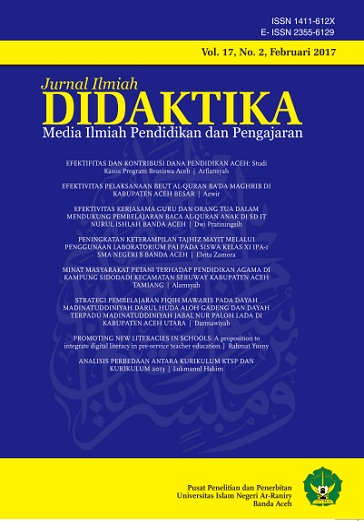STUDENTS’ CRITICAL THINKING REFLECTED IN THEIR WRITTEN RESPONSES ON NICENET
DOI:
https://doi.org/10.22373/jid.v18i2.3238Keywords:
Critical Thinking, Writing, Nicenet ICAAbstract
This research was conducted to analyze the student’s critical thinking in writing responses on Nicenet Internet Classroom Assistant (ICA) based on Anderson and Krathwohl theory. It is a qualitative research with content analysis method. The subject of this research was the document of students’ responses in online class Nicenet ICA in Communication Management subject that was conducted in semester seven in 2014, batch 2010 and 2011 in the Department of English Language Education of UIN Ar-Raniry Banda Aceh. The result of this study suggested that participating in Nicenet ICA gave positive effects on students in increasing their critical thinking skill in writing. This can be seen through the final result that 92.30% of those documents represent the critical thinking ability in the highest level while the rest were in the medium. It can be inferred from this study that the use of Nicenet as a media of learning can promote and develop the students’ critical thinking skill.References
Bloom, B. S., A Taxonomy of Educational Objectives. Handbook 1: Cognitive Domain. New York: David McKay Co Inc, 1956.
Carol. B.,et. al, in Writing@CSU. Content Analysis.Colorado State University, (1994-2012) Retrieved October 25, 2015 from
http://writing.colostate.edu/guides/guide.cfm?guideid=61.
Dawson, P. Assessment Rubrics: Towards Clearer and More Replicable Design, Research and Practice.Assessment and Evaluation in Higher Education, 2015. Retrieved November 25, 2015 from
http://www.tandfonline.com/doi/full/10.1080/02602938.2015.1111294
Duron, R., Limbach, B and Waugh, W. Critical Thinking Framework For Any Discipline. International Journal of Teaching and Learning in Higher Education, 17 (2), 2006.
Edward S. &Dennis S., Is a Critical Pedagogy for the Profession of Social Work Possible? Journal of Teaching in Social Work. 25 (3-4), 2005.
King, A. Designing the Instructional Process to Enhance Critical Thinking Acrossthe Curriculum. Teaching of Psychology, 22(1), 1995.
Megan.J. O., Using Rubrics to Collect Evidence for Decision-Making. What do Librarians Need to Learn. 2 (3), 2007. Retrieved December 20, 2015 from
https://ejournals.library.ualberta.ca/index.php/EBLIP/article/view/261.
Popham W. J. What's Wrong and What's Right with Rubrics. Educational Leadership, 55 (2), 1997.
Scriven, M., & Paul, R. (2004). The Critical Thinking Community. Retrieved on November 28th, 2015, from http://www.criticalthinking.org/aboutCT/defin ingCT.shtml.
Scriven, M., & Paul, RDefining Critical Thinking, 2005. Retrieved February 10, 2015 from http://www.criticalthinking.org/aboutCT/definingCT.cfm.
Tickton, G. S. To Improve Learning: An Evaluation of Instructional Technology. New York: R.R Bowker, 1970.
Tuan, L. T.,. Teaching Writing Through Reading Integration. Journal of Language Teaching and Research, 3 (3), 2012.









